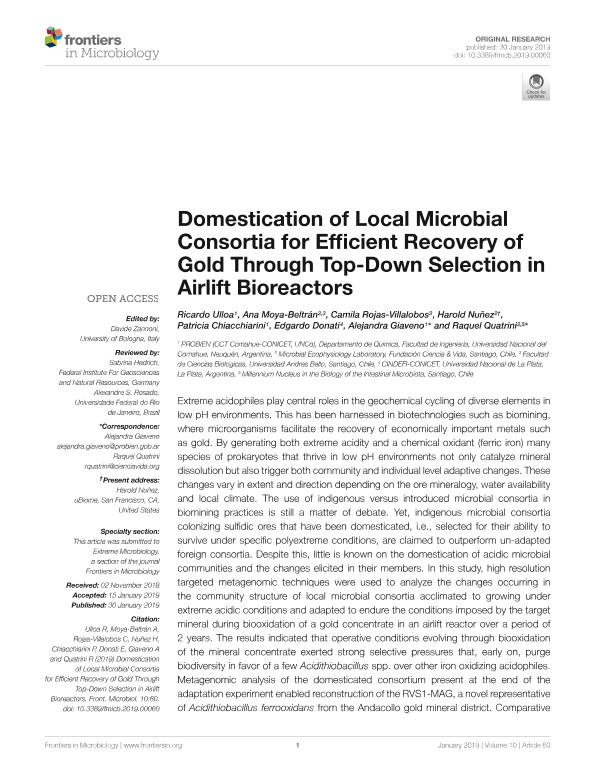Mostrar el registro sencillo del ítem
dc.contributor.author
Ulloa, Ricardo
dc.contributor.author
Moya Beltrán, Ana
dc.contributor.author
Rojas Villalobos, Camila
dc.contributor.author
Nuñez, Harold
dc.contributor.author
Chiacchiarini, Patricia Alejandra

dc.contributor.author
Donati, Edgardo Ruben

dc.contributor.author
Giaveno, Alejandra
dc.contributor.author
Quatrini, Raquel
dc.date.available
2021-01-14T13:28:45Z
dc.date.issued
2019-04
dc.identifier.citation
Ulloa, Ricardo; Moya Beltrán, Ana; Rojas Villalobos, Camila; Nuñez, Harold; Chiacchiarini, Patricia Alejandra; et al.; Domestication of local microbial consortia for efficient recovery of gold through top-down selection in airlift bioreactors; Frontiers Media S.A.; Frontiers in Microbiology; 10; 60; 4-2019; 1-14
dc.identifier.issn
1664-302X
dc.identifier.uri
http://hdl.handle.net/11336/122711
dc.description.abstract
Extreme acidophiles play central roles in the geochemical cycling of diverse elements in low pH environments. This has been harnessed in biotechnologies such as biomining, where microorganisms facilitate the recovery of economically important metals such as gold. By generating both extreme acidity and a chemical oxidant (ferric iron) many species of prokaryotes that thrive in low pH environments not only catalyze mineral dissolution but also trigger both community and individual level adaptive changes. These changes vary in extent and direction depending on the ore mineralogy, water availability and local climate. The use of indigenous versus introduced microbial consortia in biomining practices is still a matter of debate. Yet, indigenous microbial consortia colonizing sulfidic ores that have been domesticated, i.e., selected for their ability to survive under specific polyextreme conditions, are claimed to outperform un-adapted foreign consortia. Despite this, little is known on the domestication of acidic microbial communities and the changes elicited in their members. In this study, high resolution targeted metagenomic techniques were used to analyze the changes occurring in the community structure of local microbial consortia acclimated to growing under extreme acidic conditions and adapted to endure the conditions imposed by the target mineral during biooxidation of a gold concentrate in an airlift reactor over a period of 2 years. The results indicated that operative conditions evolving through biooxidation of the mineral concentrate exerted strong selective pressures that, early on, purge biodiversity in favor of a few Acidithiobacillus spp. over other iron oxidizing acidophiles. Metagenomic analysis of the domesticated consortium present at the end of the adaptation experiment enabled reconstruction of the RVS1-MAG, a novel representative of Acidithiobacillus ferrooxidans from the Andacollo gold mineral district. Comparative genomic analysis performed with this genome draft revealed a net enrichment of gene functions related to heavy metal transport and stress management that are likely to play a significant role in adaptation and survival to adverse conditions experienced by these acidophiles during growth in presence of gold concentrates.
dc.format
application/pdf
dc.language.iso
eng
dc.publisher
Frontiers Media S.A.

dc.rights
info:eu-repo/semantics/openAccess
dc.rights.uri
https://creativecommons.org/licenses/by-nc-sa/2.5/ar/
dc.subject
ACIDITHIOBACILLUS
dc.subject
ACIDOPHILES
dc.subject
ADAPTATION
dc.subject
CONSORTIA
dc.subject
DOMESTICATION
dc.subject
METAGENOME DERIVED ASSEMBLY
dc.subject
TARGETED METAGENOMICS
dc.subject.classification
Otras Biotecnología Industrial

dc.subject.classification
Biotecnología Industrial

dc.subject.classification
INGENIERÍAS Y TECNOLOGÍAS

dc.title
Domestication of local microbial consortia for efficient recovery of gold through top-down selection in airlift bioreactors
dc.type
info:eu-repo/semantics/article
dc.type
info:ar-repo/semantics/artículo
dc.type
info:eu-repo/semantics/publishedVersion
dc.date.updated
2020-11-25T17:58:54Z
dc.journal.volume
10
dc.journal.number
60
dc.journal.pagination
1-14
dc.journal.pais
Suiza

dc.description.fil
Fil: Ulloa, Ricardo. Consejo Nacional de Investigaciones Científicas y Técnicas. Centro Científico Tecnológico Conicet - Patagonia Norte. Instituto de Investigación y Desarrollo en Ingeniería de Procesos, Biotecnología y Energías Alternativas. Universidad Nacional del Comahue. Instituto de Investigación y Desarrollo en Ingeniería de Procesos, Biotecnología y Energías Alternativas; Argentina
dc.description.fil
Fil: Moya Beltrán, Ana. Fundación Ciencia & Vida; Chile. Universidad Andrés Bello; Chile
dc.description.fil
Fil: Rojas Villalobos, Camila. Fundación Ciencia & Vida; Chile
dc.description.fil
Fil: Nuñez, Harold. Fundación Ciencia & Vida; Chile
dc.description.fil
Fil: Chiacchiarini, Patricia Alejandra. Consejo Nacional de Investigaciones Científicas y Técnicas. Centro Científico Tecnológico Conicet - Patagonia Norte. Instituto de Investigación y Desarrollo en Ingeniería de Procesos, Biotecnología y Energías Alternativas. Universidad Nacional del Comahue. Instituto de Investigación y Desarrollo en Ingeniería de Procesos, Biotecnología y Energías Alternativas; Argentina
dc.description.fil
Fil: Donati, Edgardo Ruben. Consejo Nacional de Investigaciones Científicas y Técnicas. Centro Científico Tecnológico Conicet - La Plata. Centro de Investigación y Desarrollo en Fermentaciones Industriales. Universidad Nacional de La Plata. Facultad de Ciencias Exactas. Centro de Investigación y Desarrollo en Fermentaciones Industriales; Argentina
dc.description.fil
Fil: Giaveno, Alejandra. Consejo Nacional de Investigaciones Científicas y Técnicas. Centro Científico Tecnológico Conicet - Patagonia Norte. Instituto de Investigación y Desarrollo en Ingeniería de Procesos, Biotecnología y Energías Alternativas. Universidad Nacional del Comahue. Instituto de Investigación y Desarrollo en Ingeniería de Procesos, Biotecnología y Energías Alternativas; Argentina
dc.description.fil
Fil: Quatrini, Raquel. Fundación Ciencia & Vida; Chile. Millennium Nucleus in the Biology of the Intestinal Microbiota; Chile
dc.journal.title
Frontiers in Microbiology
dc.relation.alternativeid
info:eu-repo/semantics/altIdentifier/url/https://www.frontiersin.org/article/10.3389/fmicb.2019.00060/full
dc.relation.alternativeid
info:eu-repo/semantics/altIdentifier/doi/http://dx.doi.org/10.3389/fmicb.2019.00060
Archivos asociados
